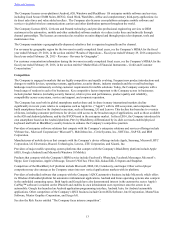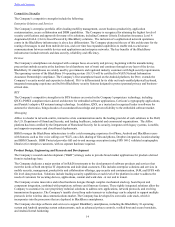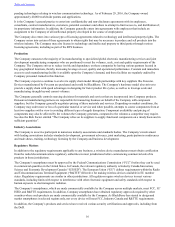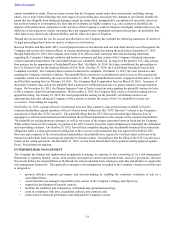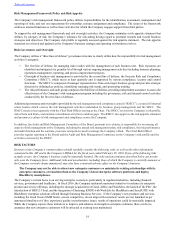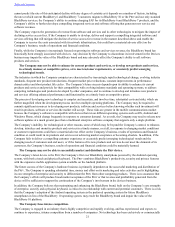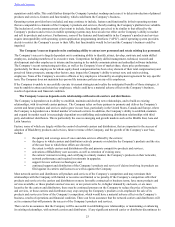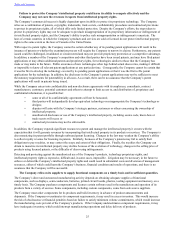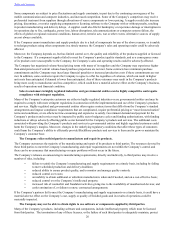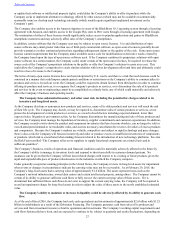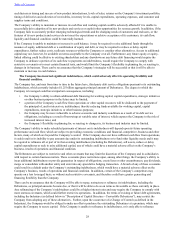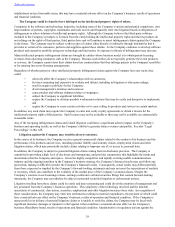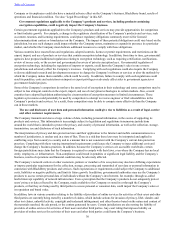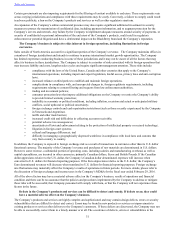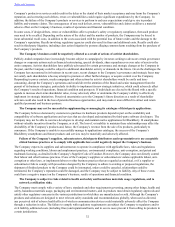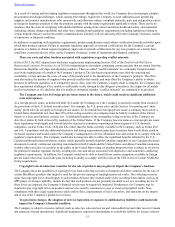Blackberry 2016 Annual Report Download - page 32
Download and view the complete annual report
Please find page 32 of the 2016 Blackberry annual report below. You can navigate through the pages in the report by either clicking on the pages listed below, or by using the keyword search tool below to find specific information within the annual report.
Table of Contents
23
reputation could suffer. This could further disrupt the Company’s product roadmap and cause it to delay introduction of planned
products and services, features and functionality, which could harm the Company’s business.
Operating system providers have included, and may continue to include, features and functionality in their operating systems
that are comparable to elements of the Company’s products and services, thereby making the Company’s platform less valuable.
The inclusion of, or the announcement of an intent to include, functionality perceived to be similar to that offered by the
Company’s products and services in mobile operating systems may have an adverse effect on the Company’s ability to market
and sell its products and services. Furthermore, some of the features and functionality in the Company’s products and services
require interoperability with operating system application programming interfaces (“APIs”), and if operating system providers
decide to restrict the Company’s access to their APIs, that functionality would be lost and the Company’s business could be
impaired.
The Company’s success depends on its continuing ability to attract new personnel and retain existing key personnel.
The Company’s success is largely dependent on its continuing ability to identify, attract, develop, motivate and retain skilled
employees, including members of its executive team. Competition for highly skilled management, technical, research and
development and other employees is intense and increasing in the mobile communications and embedded software industries.
The Company’s recent restructuring activities, as well as the Company’s loss of market share, share price performance
(particularly for those employees for whom equity-based compensation has been a key element of their total compensation) and
perceived future prospects, among other factors, may impact the Company’s ability to attract new, and retain existing,
employees. None of the Company’s executive officers or key employees is bound by an employment agreement for any specific
term. The Company does not maintain key-person life insurance policies on any of its employees.
If the Company is unable to successfully execute its current strategies and realize the anticipated benefits of those strategies, it
may be unable to attract and retain key employees, which could have a material adverse effect on the Company’s business,
results of operations and financial condition.
The Company’s success depends on its relationships with network carriers and distributors.
The Company is dependent on its ability to establish, maintain and develop new relationships, and to build on existing
relationships, with its network carrier partners. The Company relies on these partners to promote and deliver the Company’s
current and future products and services and to grow its user base, particularly in the United States, Canada and Europe, where
the Company is dependent on a limited number of network carriers. In addition, the Company’s ability to establish, maintain
and expand its market reach is increasingly dependent on establishing and maintaining distribution relationships with third
party and indirect distributors. This is particularly the case in emerging and growth markets such as the Middle East, Asia and
Latin America.
Factors, some of which are largely within the control of network carriers and distributors, that are important to the success of
adoption of BlackBerry products and services, future revenue of the Company, and the growth of the Company’s user base,
include:
• the quality and coverage area of voice and data services offered by the carriers;
• the degree to which carriers and distributors actively promote or subsidize the Company’s products and the size
of the user base to which these efforts are directed;
• the extent to which carriers and distributors offer and promote competitive products and services;
• activations of BlackBerry user accounts, as well as retention of existing ones;
• the carriers’ interest in testing, and certifying in a timely manner, the Company’s products on their networks;
• network performance and required investments in upgrades;
• support for new software technologies; and
• continued support and distribution of the Company’s products and services if claims involving its products are
filed against its carriers and licensees as well as against the Company.
Most network carriers and distributors sell products and services of the Company’s competitors and may terminate their
relationships with the Company with limited or no notice and limited or no penalty. If the Company’s competitors offer their
products and services to the carriers and distributors on more favorable contractual or business terms, have more products and
services available, or those products and services are, or are perceived to be, in higher demand by end users, or are more
lucrative for the carriers and distributors, there may be continued pressure on the Company to reduce the price of its products
and services, or those carriers and distributors may stop carrying the Company’s products or de-emphasize the sale of its
products and services in favor of the Company’s competitors, which would have a material adverse effect on the Company’s
business, results of operations and financial condition. There can be no assurance that the network carriers and distributors will
act in a manner that will promote the success of the Company’s products and services.
There can be no assurance that the Company will be successful in establishing new relationships, or maintaining or enhancing
its existing relationships, with network carriers and distributors. If any significant network carrier or distributor discontinues its


